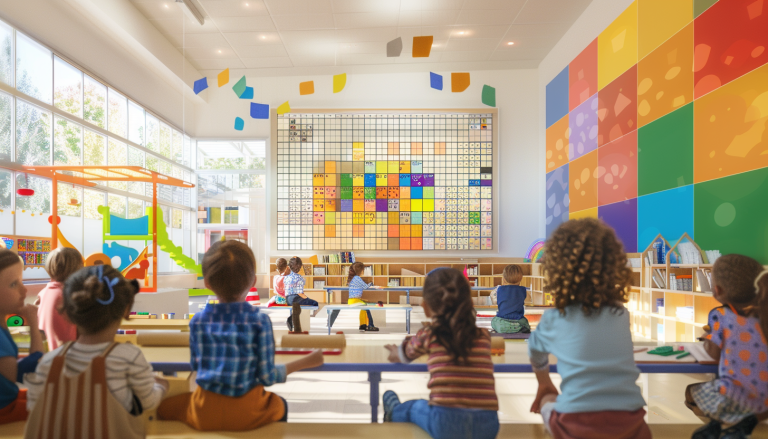Free Kinder Math Activities
Our chatbot is equipped to answer questions about all K-5 Common Core Math Standards and can also assist in creating detailed lesson plans. Save time and enhance student success with a
Vertex Premium account.
Counting and Cardinality (K.CC)
- Know number names and the count sequence (K.CC.A)
- K.CC.A.1: Count to 100 by ones and by tens.
- K.CC.A.2: Count forward beginning from any given number within the known sequence.
- K.CC.A.3: Write numbers from 0 to 20. Represent a count of zero to twenty objects with a corresponding numeral.
- Count to tell the number of objects (K.CC.B)
- K.CC.B.4: Understand the relationship between numbers and quantities; connect counting to cardinality.
- K.CC.B.4a: Count objects by saying the number names in the standard order, pairing each object with one unique number name.
- K.CC.B.4b: Recognize that the last number name said represents the total number of objects counted.
- K.CC.B.4c: Understand that each successive number name refers to a quantity one larger.
- K.CC.B.5: Answer “how many?” questions for up to 20 things in various configurations.
- Compare numbers (K.CC.C)
- K.CC.C.6: Identify if the number of objects in one group is greater, less, or equal to another group, using matching and counting strategies.
- K.CC.C.7: Compare two numbers between 1 and 10 presented as written numerals.
Operations and Algebraic Thinking (K.OA)
- Fundamental operations (K.OA.A)
- K.OA.A.1: Represent addition and subtraction with various methods (objects, fingers, drawings, etc.).
- K.OA.A.2: Solve addition and subtraction word problems within 10 using objects or drawings.
- K.OA.A.3: Decompose numbers less than or equal to 10 in more than one way.
- K.OA.A.4: Find the number that makes 10 when added to numbers from 1 to 9.
- K.OA.A.5: Fluently add and subtract within 5.
Number and Operations in Base Ten (K.NBT)
- Foundations for place value (K.NBT.A)
- K.NBT.A.1: Compose and decompose numbers from 11 to 19 into ten ones and additional ones.
Measurement and Data (K.MD)
- Describe and compare measurable attributes (K.MD.A)
- K.MD.A.1: Describe measurable attributes of objects, such as length or weight.
- K.MD.A.2: Compare two objects with a common attribute to see which has “more of” or “less of” the attribute.
- Classify objects and count the number of objects in categories (K.MD.B)
- K.MD.B.3: Classify objects into categories, count the objects in each category, and sort the categories by count.
Geometry (K.G)
- Identify and describe shapes (K.G.A)
- K.G.A.1: Describe objects using names of shapes and their relative positions.
- K.G.A.2: Name shapes regardless of their orientations or overall size.
- K.G.A.3: Identify shapes as two-dimensional or three-dimensional.
- Analyze, compare, create, and compose shapes (K.G.B)
- K.G.B.4: Analyze and compare two- and three-dimensional shapes in different sizes and orientations.
- K.G.B.5: Model shapes by building from components and drawing them.
- K.G.B.6: Compose simple shapes to form larger shapes.
The Role of Math Common Core Standards in Kindergarten
The Common Core Standards aim to equip students with the critical thinking, problem-solving, and analytical skills necessary for success in higher education, career, and life. For kindergarteners, these standards are designed to create a solid foundation in basic mathematics concepts and skills. They cover key areas such as counting and cardinality, operations and algebraic thinking, and basic geometry.
Why Focus on Math Common Core Standards?
- Structured Learning: These standards provide a clear roadmap for what young students need to learn, allowing educators and parents to track progress and ensure all necessary topics are covered.
- Preparation for Future Learning: Early mathematical education is crucial as it sets the groundwork for more complex concepts. By aligning with the Common Core, students develop a consistent and deep understanding from the very start.
- Equity and Accessibility: Common Core Standards ensure every student has access to the same high-quality education and learning expectations, regardless of where they live or go to school.
How Our Platform Supports Kindergarten Math Learning
Our
adaptive learning platform is specifically designed to align with the
Math Common Core Standards for Kindergarten. We offer a variety of engaging and interactive activities that not only meet these standards but also adapt to each child’s learning pace, making math fun and accessible. Below are some of the free activities available on our platform that support these standards:
- Counting and Cardinality: Activities such as “Count on frames up to 10” and “Count to 20 by ones” help children master number sequences and understand the relationship between numbers and quantities.
- Operations and Algebraic Thinking: Exercises like “Add & Subtract within 5” and “Word Problems: Addition & Subtraction within 10” develop young students’ ability to perform basic operations and solve problems.
- Geometry: Through games that encourage them to “Name Shapes in Various Orientations” and “Understand Object Positions,” children learn to identify and describe shapes and their attributes.
- Measurement and Data: Children engage in activities like “Describe Measurable Attributes of Objects,” enhancing their understanding of size, weight, and other measurable attributes.
Tracking Progress and Mastery
One of the unique features of our platform is the ability to track mastery percentage next to each skill. Parents and educators can see at a glance how well a child is grasping each concept, allowing for timely intervention and support if needed. This feature is available once you log in, and you can create a free child account
here.
In Summary
Incorporating the
Math Common Core Standards for Kindergarten into early education ensures that students are not only prepared for future academic challenges but are also equipped with the skills to think critically and solve problems efficiently. Our platform’s specialized activities make learning these standards engaging and effective. Try them out and see the difference in your child’s mathematical abilities!






